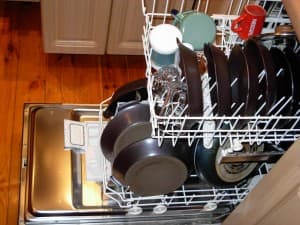April showers bring May flowers and the onset of spring, which means it’s time for “spring cleaning.” Gene Johnson Heating, Cooling, Plumbing and Electrical offers these maintenance tips to protect your home against plumbing problems.
Kitchen/Bathrooms
Check faucets for drips or leaks. Make repairs to save water.
- Ensure that all drains have strainers to prevent hair, soap and debris from clogging the drain lines.
- Check toilets for hidden leaks. Add six drops of food coloring to the toilet tank. If the toilet is leaking, color will appear in the bowl within 30 minutes.
- Inspect tank and bowl for cracks or leaks.
- Exercise water supply valves under sinks and toilets to prevent them from sticking.
- Make sure toilets flush properly. If the handle must be held down for a thorough flush or jiggled to stop the water from running you may need to replace worn tank parts. They’re inexpensive and you’ll notice a lower water bill.
- Clean mineral deposits from shower head. Unscrew it and soak in vinegar or fill a plastic baggie with vinegar; place it over the shower head and hold in place with a rubber band. Soak overnight then remove and gently scrub with an old toothbrush to remove deposits.
Appliances
- Check the temperature setting on the water heater. It should be set no higher than 120°F to prevent scalding and reduce energy use.
- Carefully drain several gallons from the water heater tank to flush out corrosion causing sediment, which reduces heating efficiency and shortens the life of the heater. Check your water heater manufacturer ‘s website for specific instructions concerning your make and model.
- Consider replacing a water heater more than 15 years old. (The first four numbers of the serial number represent the month and year it was made.) Newer water heaters are more energy efficient.
- Make sure flammables are not stored near the water heater or furnace.
Check dishwasher, washing machine and ice maker supply hoses for bulges or leaks. Replace hoses showing signs of weakness or older than ten years. Use stainless steel hoses wherever possible. They are more reliable and less prone to bursting than other types.
- Clean out washing machine lint trap, if equipped, and place a wire trap or a piece of pantyhose over the end of the hose that drains the washer.
General
- Pour a gallon of water into infrequently used drains (including floor drains) to fill the trap and prevent odors from entering the house. Slow floor drains should be snaked to ensure they will carry away water quickly in the event of a flood.
- Check exposed pipes under sinks and in the basement for signs of leaks.
- If your home has a sump pump, make sure it operates properly by pouring a few buckets of water into the sump pit. The pump should quickly turn on, discharge the water then shut off without any problems.
- Install a backflow valve in the floor drain if you live in an area where sewers sometimes backup into homes. This device will prevent future backups.
- Inspect for slow leaks in your home by taking a reading on your water meter before bedtime. The next morning, without using any water overnight, take another reading. If the reading has changed you have a leak that should be repaired.
- Install flood alarms. Like a smoke alarm, a flood alarm is a battery-operated device that sounds an alarm when it comes in contact with water. It alerts you to potential flooding or leaks.
Outside
- Make sure yard drains, gutters and downspouts are cleaned out, open, and free of debris.
- Check for bird nests in plumbing vent pipes.
- Check faucets and hose bibs to make sure water flows freely. If an outdoor faucet drips or if there is leakage inside your home the first time the hose is turned on, you may have had a frozen pipe that cracked and needs to be replaced.


 Check dishwasher, washing machine and ice maker supply hoses for bulges or leaks. Replace hoses showing signs of weakness or older than ten years. Use stainless steel hoses wherever possible. They are more reliable and less prone to bursting than other types.
Check dishwasher, washing machine and ice maker supply hoses for bulges or leaks. Replace hoses showing signs of weakness or older than ten years. Use stainless steel hoses wherever possible. They are more reliable and less prone to bursting than other types.



